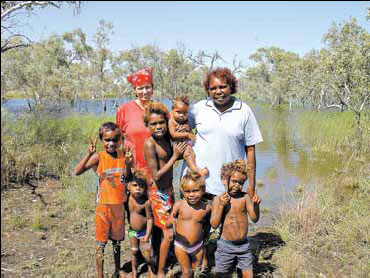A village invents a language all its own
Updated: 2013-07-28 08:29
By Nicholas Bakalar(The New York Times)
|
|||||||
|
Youngsters in Lajamanu, in northern Australia, speak Light Warlpiri, which they created. Carmel O'Shannessy, back left, studies the native tongue. Noressa White |
There are many dying languages. But at least one has recently been born, created by children living in a remote village in northern Australia.
Carmel O'Shannessy, a linguist at the University of Michigan, has been studying the young people's speech for more than a decade and has concluded that they speak neither a dialect nor the mixture of languages called a creole, but a new language with unique grammatical rules.
The language, called Warlpiri rampaku, or Light Warlpiri, is spoken only by people under 35 in Lajamanu, a village of about 700 people in Australia's Northern Territory. In all, about 350 people speak the language as their native tongue. Dr. O'Shannessy's latest study of Light Warlpiri is in the June issue of Language.
"Many of the first speakers of this language are still alive," said Mary Laughren, a research fellow in linguistics at the University of Queensland in Australia, who was not involved in the studies. One reason Dr. O'Shannessy's research is so significant, she said, "is that she has been able to record and document a 'new' language in the very early period of its existence."
Everyone in Lajamanu speaks "strong" Warlpiri, an aboriginal language unrelated to English and shared with about 4,000 people in several Australian villages. Many also speak Kriol, an English-based creole that is widely spoken in northern Australia among aboriginal people of many native languages.
Lajamanu's isolation may have something to do with the creation of a new way of speaking. The village is about 900 kilometers south of Darwin, and the nearest commercial center is Katherine, about 550 kilometers north.
People in Lajamanu often engage in what linguists call code-switching, mixing languages together or changing from one to another as they speak. And many words in Light Warlpiri are derived from English or Kriol. But Light Warlpiri is not simply a combination of words from different languages.
Dr. O'Shannessy offers this example: Nganimpa-ng gen wi-m si-m worm mai aus-ria. (We also saw worms at my house.)
It is easy to see nouns derived from English. But the -ria ending on "aus" (house) means "in" or "at," and it comes from Warlpiri. The -m ending on the verb "si" (see) indicates that the event is either happening now or has happened, a "present or past but not future" tense that does not exist in English or Warlpiri. This is a way of talking so different from either Warlpiri or Kriol that it constitutes a new language.
The development of the language, Dr. O'Shannessy says, began with parents using baby talk with their children in a combination of the three languages. But the children took that language as their native tongue by adding radical innovations to the syntax, especially in the use of verb structures, that are not present in any of the source languages.
Why a new language developed at this time and in this place is not entirely clear. It was not a case of people needing to communicate when they have no common language, a situation that can give rise to pidgin or creole.
Dr. O'Shannessy suggests that subtle forces may be at work. "I think that identity plays a role," she said. "After children created the new system, it has since become a marker of their identity as being young Warlpiri from the Lajamanu Community."
The New York Times
(China Daily 07/28/2013 page11)
